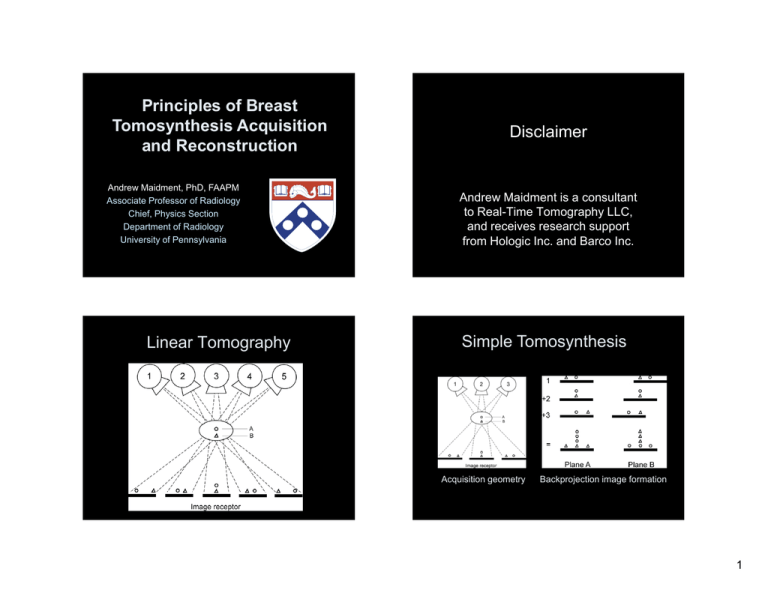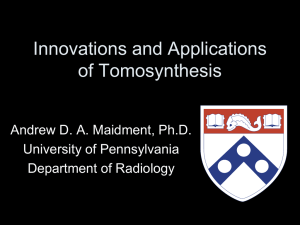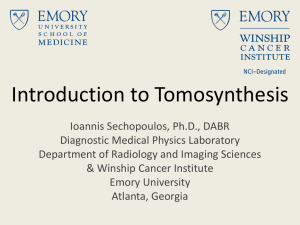Principles of Breast Tomosynthesis Acquisition and Reconstruction Disclaimer
advertisement

Principles of Breast Tomosynthesis Acquisition and Reconstruction Andrew Maidment, PhD, FAAPM Associate Professor of Radiology Chief, Physics Section Department of Radiology University of Pennsylvania Linear Tomography Disclaimer Andrew Maidment is a consultant to Real-Time Tomography LLC, and receives research support from Hologic Inc. and Barco Inc. Simple Tomosynthesis Acquisition geometry Backprojection image formation 1 Hologic Selenia Dimensions * • 2D and 3D Imaging under same compression • W Tube with Rh, Ag and Al Filtration • 15 degree tomosynthesis sweep, 15 images, <5 second Tomosynthesis acquisition • 200 mA generator, 0.1/0.3 mm focal spot • 70 cm source-to-detector distance • Retractable High Transmission Cellular grid • 24 x 29 cm Selenium Direct Detector Current Systems * Investigational Device -Limited by United States Law to Investigational Use T. Mertelmeier 05/2006 Invasive Ductal Carcinoma 8 Digital Breast Tomosynthesis Modified mammo unit for large angle range (± 25o) Fast a-Se detector 24 x 30 cm2 High DQE at low exposures Several readout & acquisition modes 1… 2 fps Up to 49 projections CC and MLO Work in progress Images courtesy of Dr. Jelle Teertstra NKI-AVL, The Netherlands 2 T. Mertelmeier 05/2006 slice close to the surface of the breast slice at z = 21 mm above patient table 9 Human subject Age 68 MLO position 6 cm compressed 28 kVp, W/Rh 133 mAs 49 projections 39 s scan 1 mm slices Photon Counting Tomosynthesis scar (benign biopsy 1980) invasive ductal CA with lobular component Image data Duke University, Dr. Jay Baker Work in progress Doc. No/Page 10(xx) 2007-xx-xx/Signature Proc SPIE 5745, 529-540 (2005) Geometry • One sweep 3D data • Multi-slit photon counting: no electronic noise, no ghosting, no scattered radiation Doc.No/Page No/Page 11(xx) Doc. 11(xx) 2007-xx-xx/Signature 2007-xx-xx/Signature 3 Case 1: Potential to reduce false-negative diagnoses GE DS DBT Prototype Detector: - a-Si (CsI) - 23×19.2 cm2 area - 100 m pixel size Tomosynthesis Slice (Z = 24mm) LMLO Acquisition: - 15 projections - 40o arc (38o actual) - 15s acquisition - Mo/Mo, Mo/Rh and Rh/Rh Invasive Carcinoma Courtesy of Tao Wu, Ph.D. Tomosynthesis Mammography Reconstruction Using a Maximum Likelihood Method Case 2: Potential to reduce false-positive diagnoses Courtesy of Tao Wu, Ph.D. LMLO 4 Case 2: Potential to reduce false-positive diagnoses Courtesy of Tao Wu, Ph.D. Z = 0 mm Z = 10 mm Z = 15 mm Z = 20 mm Image Theory Z = 25 mm Z = 30mm Z = 35 mm Z = 40 mm SPIE MI 2006 6142-15 Linear Tomography Feb 12,.2006 20 Tomosynthesis Reconstruction Sampling geometry ± Fourier slice theorem sampling is incomplete (in Fourier space) approximative inversion only artifacts 5 fz 45 V, 22° 23 V, 11° 12 V, 5.5° 6 V, 2.5° fx Tissue Imaging 1 0.08 SDNR (normalized) 0.07 Contrast 0.06 0.05 0.04 0.03 0.02 0.8 0.6 0.4 0.2 0.01 0 0 50 100 150 200 0 0 Angular Extent () 50 100 150 200 Angular Extent () Angular Spacing, ∆θ=2° 6 Angular Range • Increasing the angular range has the effect of: fz fx – Increasing the z-resolution – Decreasing the in-focus plane thickness – Increasing the blurring of out of plane objects – Increasing the rate of blurring of out of plane objects • There is a point of diminishing returns that varies with the pixel size 45 V, 22° 23 V, 22° 12 V, 22° 6 V, 22° 7 48 12 Number of Projections • Increasing the number of projections reduces the conspicuity of artifacts • The number of projections depends upon: – the angular range, – the pixel size, – the contrast of attenuating objects – the detector physics – anatomical constraints Difference Breast CT Breast Tomosynthesis B.3 - 3D spatial frequency domain CT Modern Multi-slice VCT scanners have nearly isotropic response with maximum spatial frequencies of .8 to 1.0 cycles/mm Courtesy J. Boone 32 z y x Courtesy M Flynn 8 B.3 - 3D spatial frequency domain TS vs CT Unsampled frequencies along 33 fz Simple Backprojection Filtered Backprojection fy the y axis make TS and CT complimentary. fx Courtesy M Flynn Tomosynthesis 296 Geometric Accuracy • Anthropomorphic phantom: • • • • 450 ml volume 5cm compressed thickness 200 micron isotropic resolution 40% overall glandularity • Fiducial markers • 1-voxel (200 micron) large • μ = 30 × μ(dense tissue) • 3 different distances from the breast support • 6.4 mm, 25.6 mm, 44.8 mm • 4 markers in a 20 mm square Mammogram 6.4 mm 25.6 mm 44.8 mm Breast CT 9 Methods: Simulated Acquisition of Phantom DBT Images Methods: Simulated Acquisition of Phantom DBT Images • Phantom images are simulated assuming mono-energetic x-ray beam without scatter, and an ideal detector. DBT Projection Phantom Section X-ray Projection Reconstructed Image DBT Reconstructed Image Methods: Supersampling Results: Marker Position Error 0.25 4 4 3.5 3 2.5 2 1.5 1 6.1 6.2 6.3 6.4 6.5 x (mm) from Chest Wall 6.6 3 x 10 4 (xC-xT) (yC-yT) (zC-zT) Ep 0.20 Error (mm) Supersampled reconstructed Image Intensity x 10 Supersampled reconstructed Image Intensity • We reconstructed a series of 10 images with sub-pixel shifts within the plane of reconstruction and combined them to form a supersampled image. 0.15 0.10 0.05 2.5 0.00 0 10 20 30 40 50 2 Reconstructed Plane Depth z(mm) 1.5 6.52 6.53 6.54 6.55 6.56 x (mm) from Chest Wall 6.7 6.8 6.57 EP were averaged over all markers at the same depth in the phantom. (Error bars = one SD.) Shown separately are the errors along each coordinate. 10 Super-Resolution FWHM Relative Error (%) Results: Marker Size Error This presentation studies super-resolution (SR), where multiple low resolution (LR) images are combined to achieve sub-pixel resolution. 200% 6.4 mm 25.6 mm 44.8 150% 100% 50% 0% 0 0.2 0.4 0.6 0.8 1 1.2 Distance from the Plane of Focus (mm) Relative marker size error was averaged over all markers at the same depth in the phantom. Although SR has been described in modalities such as satellite imaging and computerized tomography, its potential in digital breast tomosynthesis (DBT) has not yet been identified. Courtesy Sung Park Results for Central Projection Results for Central Projection 2.1 lp/mm 0.6 0.4 Signal 0.2 0 –0.2 –0.4 –0.6 –0.8 –1.0 –0.6 0.4 –0.2 0 0.2 Position (mm) Sinusoidal Input (Normalized) –0.4 0.6 1.0 2.00 0.8 0.6 1.75 0.4 1.50 0.2 Input Freq. 5.0 lp/mm 1.25 1.00 0 –0.2 0.75 –0.4 0.50 –0.6 0.25 –0.8 0 2.25 Fourier Transform Modulus (mm) Fourier Transform Modulus (mm) 0.8 2.25 Signal 1.0 0 2 4 6 8 10 12 Spatial Frequency (lp/mm) 14 –1.0 –0.6 Alias Freq. 3.6 lp/mm 2.00 1.75 1.50 Input Freq. 5.0 lp/mm 1.25 1.00 0.75 0.50 0.25 –0.4 –0.2 0 0.2 0.4 0.6 Position (mm) Sinusoidal Input (Normalized) Central Projection (Parallel X-Ray Beam) 0 0 2 4 6 8 10 12 14 Spatial Frequency (lp/mm) Central Projection (Parallel X-Ray Beam) Parallel Beam Geometry: The input frequency (5.0 lp/mm) is imaged as if it were 2.1 lp/mm. These two frequencies are equidistant from the alias frequency (3.6 lp/mm). 11 Filtered Backprojection (FBP) 2.0 A) Central Projection 4.5 1.6 1.2 0.8 0.4 0 –0.4 –0.8 –1.2 B) Reconstruction Input Freq. 5.00 lp/mm 4.0 Fourier Transform Modulus Attenuation Coefficient μ (mm-1) Bar Pattern Phantom 3.5 3.0 2.5 2.0 1.5 1.0 0.5 –1.6 –2.0 –0.6 –0.4 –0.2 0.2 0 Position (mm) Sinusoidal Input FBP (RA Filter) FBP (RA and SA Filters) 0.4 0.6 0 0 2 4 6 8 10 12 Spatial Frequency (lp/mm) FBP (RA Filter) FBP (RA and SA Filters) 14 Although reconstruction with the RA filter alone has the benefit of higher modulation, it generates high frequency spectral leakage and flattening artifacts in the spatial domain. The SA filter removes some of these artifacts. The reconstruction can clearly distinguish frequencies higher than the detector alias frequency 0.5a-1 (3.6 lp/mm). Instead, the resolution is limited by the resolution of the x-ray converter. This ability is not present in acquiring the central projection alone. Anisotropy due to Oblique Incidence Clinical Application fz F1 F2 F3 f Detector Center Reconstruction with 140 μm voxels + Interpolation at 35 μm. Reconstruction with 35 μm voxels + No Further Interpolation. Conventional Image Super-Resolution Image R D Detector Edge 12 Fourier Slice Thereom Anisotropy of GE System This presentation extends our prior research on super-resolution to an obliquely pitched reconstruction plane. • Source-to-COR: 48 cm • COR-to-Detector: 20 cm • Central Projection: α = 0° Fourier Domain Spatial Domain Incident X-Ray Beam Final Projection νz Null Space • θ varies between 0° at midpoint of chest wall and 18.1° opposite chest wall. ψ Object Intermediate Projection νx ψ z x Detector First Projection Unexpectedly, we demonstrate that super-resolution is possible in areas of Fourier space not sampled by any individual projection. Methods Bar Pattern Phantom Pitch 30° Pitch 60° Super-resolution up to 5.0 lp/mm Resolution up to 3.0 lp/mm The Selenia Dimensions system (Hologic Inc., Bedford, MA) having 15 projections is simulated, assuming no sources of noise or blurring. The pitch (30°) is well outside the angular sampling of the scanner: -7.5° to 7.5°. Reconstruction is performed along the oblique pitch of the input. (2 cos ε ′) ν 0x z z′ x′ Pitch 30º x Two reconstruction methods are considered: simple backprojection (SBP) and filtered backprojection (FBP). 13 Clinical Application Magnification of Recon. with 140 μm voxels at 0° pitch Clinical Application Recon. with 35 μm voxels at 0° pitch Recon. at 0° Pitch Recon. at 30° Pitch Recon. at 0° Pitch Recon. with 35 μm voxels at 30° pitch Clinical Application Recon. at 0° Pitch Recon. at 30° Pitch Recon. with 35 μm voxels at 0° pitch As the angular range of the tomosynthesis projection (source) images is reduced, the 0% Recon. with 35 μm voxels at 0° pitch 0% 0% 0% 0% Translation of Recon. Plane at 30° pitch 1. The z-resolution is improved 2. The in-focus plane thickness is decreased 3. The blurring of out of plane objects in decreased 4. The in-plane resolution is decreased 5. The noise in the image is increased 10 14 Answer As the angular range of the tomosynthesis projection (source) images is reduced, the 3. The blurring of out of plane objects in decreased As the number of projection (source) images used in the reconstruction is increased, 0% 0% 0% 0% 0% References: A D A Maidment, et al, Evaluation of a photon-counting breast tomosynthesis imaging system, Proc. SPIE 5745 (2005). 1. The conspicuity of artifacts increases 2. The acquisition time decreases 3. The impact of detector noise is decreased through noise averaging 4. The blurring of out-of-plane structures is improved 5. In-plane resolution is increased 10 Answer As the number of projection (source) images used in the reconstruction is increased, 4. The blurring of out-of-plane structures is improved With regard to tomosynthesis spatial resolution 0% 0% 0% 0% 0% References: A D A Maidment, et al, Evaluation of a photon-counting breast tomosynthesis system, Proc. SPIE 6142 (2006). 1. It is inferior to CT spatial resolution inplane 2. In-plane spatial resolution is limited by the detector pixel size 3. It is isotropic 4. Z-resolution is limited by the number of projections 5. It is determined primarily by the x-ray converter spatial resolution 10 15 Answer With regard to tomosynthesis spatial resolution 5. It is determined primarily by the x-ray converter spatial resolution Image Reconstruction References: R J Acciavatti and A D A Maidment, Investigating the potential for super-resolution in digital breast tomosynthesis, Proc SPIE 7961 (2011). Proposed Reconstruction Methods • • • • • • • • Tomo LSF Simple Backprojection (“Shift & Add”) Filtered Backprojection ART Maximum-Likelihood Expectation Maximization Total Variational Methods Matrix Inversion (MITS) Ordered Subset methods and many more 16 Comparison of reconstruction alg. T. Mertelmeier 05/2006 65 ramp Invasive Ductal Carcinoma ramp spectral ramp spectral slice thickness ramp spectral slice thickness (optimized) Images courtesy of Dr. Jelle Teertstra NKI-AVL, The Netherlands DBT Reconstruction — Artifact Reduction Convex Hull Processing Reconstruction images without artifact reduction Courtesy S. Ng, RealTime Tomography, LLC Z = 12mm Z = 16mm Z = 27mm 17 DBT Reconstruction — Artifact Reduction Results of artifact reduction (Maximum Contribution Deduction) Z = 12mm Z = 16mm MITS FBP Multi-Planar BPF Courtesy S. Ng, RealTime Tomography, LLC Z = 27mm FBP with H&G MITS-FBP blend Iterative DBT Reconstruction Algorithms (0) Initial 3-D Model (n) Update Forward projection Calculated Projections: P (n) Measured Projections: P MITS good for high freq (calcs and margins), FBP good for low freq (parenchyma), FBP w/ filter reduces high freq noise but causes blur, MITS-FBP blend combines high & low freqs well. Slides courtesy of Ying Chen, Joseph Lo, Jay Baker, Jim Dobbins (n+1) Optimized Likelihood Function (end) Likelihood function L=P(Y|): The probability of getting the measured projections Y, given a 3-D model of the breast volume. 18 Simultaneous Algebraic Recon Technique (SART) Iterative Maximum-Likelihood (ML) 6 iter MGH case 9 iter 11 iter Chan HP, et. al. Tomosynthesis image reconstruction methods include all of the following except 0% 0% 0% 0% 0% 1 iter 2 iter (0.1) MGH case 2 iter (0.5) Chan HP, et. al. Answer 1. 3D multiscale gradient filtered reconstruction 2. Filtered back-projection 3. Back-projection filtering 4. Maximum likelihood expectation maximization 5. Total variational methods Tomosynthesis image reconstruction methods include all of the following except 1. 3D multiscale gradient filtered reconstruction References: J T Dobbins and D J Godfrey, Digital x-ray tomosynthesis: current state of the art and clinical potential, Phys. Med. Biol. 48 (2003) 10 19 Vascular Contrast Enhancement Methods • The development of an independent vasculature is an essential step in the development of a cancer • A contrast agent should be able to demonstrate these vessels and the lesion itself Functional Imaging Invasive Ductal Carcinoma Temporal Subtraction ICRU-44 Breast Tissue Iodine 0.27 mm Cu 1000 Post-contrast Subtraction 1000000 900000 800000 700000 100 600000 500000 10 400000 300000 1 Photon Fluence [# photons/mm2] Mass attenuation[cm 2/g] 10000 Pre-contrast 200000 100000 0.1 0 0 5 10 15 20 25 30 Energy [keV] 35 40 45 50 Spiculated mass with rim enhancement. 20 Temporal Subtraction • Advantages: – Superior separation of pre- and post-contrast images – High kVp pre- and post- contrast images – Reduced total dose • Disadvantages: – Motion Artifacts Dual-Energy Imaging • At diagnostic energies, there are two main x-ray interactions – Photoelectric effect – Compton effect • The relative contribution of the two effects depends upon the energy and the atomic number of the material • Therefore, the attenuation coefficients of different materials have different trends as a function of energy Dual-Energy CE-DBT (DECE-DBT) DE-DBT: Patient 2 Low Energy High Energy High Energy Low Energy • Age: 55 • Weight: • Project 3 / Left breast • Diagnosis: Invasive ductal carcinoma, poorly SI DE ( x, y ) ln(SI H ( x, y )) wt ln(SI L ( x, y )) differentiated – in situ and Invasive ductal carcinoma • Sign: mass in axillary tail region 21 Energy Subtraction DE • Advantages: – Motion artifacts are rare • Disadvantages: Temp 1 – System modifications are necessary to allow rapid change of filter material and kVp – Detector must be suited to rapid readout – Poorer separation of tissue and contrast agent – Beam hardening artifacts Temp2 Multimodality Imaging Courtesy Paul Carson, U Michigan Combined Tomo/US System 22 Courtesy Paul Carson, U Michigan Dual Modality Tomographic Scanner (UVa) Tomo with marked US During x‐ray image acquisition the gamma camera is positioned out of the beam near the tube and close to the gantry arm PLC UoM / GE GR 6/5/06 During gamma ray image acquisition the gamma camera positioned as close as possible to the chest wall edge of the compression paddle Data courtesy of Mark Williams, Ph.D. Current Protocol UVa Charlottesville, VA Positive Lymph Node • To date, researchers at U Va have imaged 18 subjects having a total of 23 biopsied lesions • 25 mCi Tc‐99m Sestamibi • 2 mGy absorbed dose to breast • 8 mSv effective whole body dose Single 1 mm thick slice Infiltrating Ductal Carcinoma Data courtesy of Mark Williams, Ph.D. UVa Charlottesville, VA X‐Ray Slice Fused Slice 23 Advantages of tomosynthesis • Improves conspicuity by removing overlying structures • Permits section imaging with high resolution in coronal view and limited MPR • Easily performed on the high volume of radiography patients • Lower radiation dose compared with CT • Lower cost compared with CT 24







